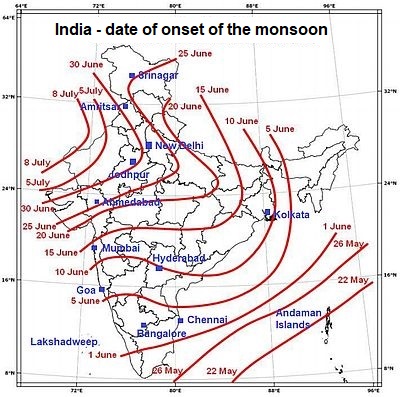Select units of measurement for the temperature and rainfall tables (metric or imperial).
June is the first summer month in the Northern Hemisphere. In India, a large country crossed by the Tropic of Cancer in the center-north, it is generally a
very hot month, and is characterized by the arrival of the
summer monsoon, which crosses the country from the southeast to the northwest, and puts an end to the long, hot and dry period.

The
temperature is high almost everywhere, especially in inland and low-altitude areas, where there can be heat waves, during which extremely high values can be reached, even 47/78 °C (117/118 °F) in the center-north.
In the north, in the Indo-Gangetic plain, and in the northwest, in the Thar desert, June is the hottest month of the year.
In the south, on the other hand, the temperature decreases compared to May, however, there can still be heat waves, especially in inland areas.
As for the
rainfall, it is very abundant in the south-west, on the coast west of the Western Ghats (see Mumbai, Mangalore, Goa, Kochi), where it ranges from 500 to 1,000 mm (20 to 40 in) per month.
On the islands, both those of the south-west (Laccadive, see Minicoy), and those of the south-east (Nicobar and Andaman, see Port Blair), the rains are abundant, and also very frequent, given that the monsoon arrives earlier.
Another very rainy area is the north-east (see Kolkata), especially at the foot of the mountains (see North Lakhimpur, Gangtok). In Meghalaya, the highest values in the world are reached in June and July (more than 3,000 millimetres or 120 inches per month).
Instead, the rains are rare in the north-west, in Punjab and Rajasthan (see Amritsar, Jodhpur), where the monsoon arrives later, at the end of June or even at the beginning of July.
In the inland areas of the center-south (see Hyderabad, Bangalore), the rainfall is moderate, while in the south, in Tamil Nadu, protected by the Western Ghats, it is actually quite scarce and irregular, especially in the inland and low-altitude areas (see Coimbatore, Madurai, Tiruchirappalli).
In June,
tropical cyclones can occur. Normally, in this month the south is spared, and cyclones hit the coast of the Arabian Sea in the west (in the states of Maharastra and Gujarat), and the coast of the Bay of Bengal in the east (north of Andhra Pradesh, Odisha and West Bengal), sometimes affecting the interior, albeit with less intensity. The period in which they are most likely, in this first phase which coincides with the arrival of the monsoon, is from the end of April to the beginning of June.
India is located at medium-low latitudes, however, in June the
days are quite long in the northern part, where the sun remains above the horizon for about 14 hours on average. June 21 is the summer solstice, i.e. the longest day of the year, in the Northern Hemisphere.
The
sea is warm enough to swim in everywhere.
India - Climate data in June| City | Rainfall | Sun | Daylight |
|---|
| (north to south) | Min | Max | Days | Hours | Hours |
|---|
Srinagar
(1 600 m.) | 15 | 29 | 35 | 5 | 8,2 | 14.4 |
|---|
Amritsar
(230 m.) | 25 | 40 | 60 | 4 | 9,0 | 14.2 |
|---|
| New Delhi | 28 | 39 | 80 | 6 | 7,3 | 13.9 |
|---|
| North Lakhimpur | 24 | 31 | 635 | 20 | 5,5 | 13.8 |
|---|
Jodhpur
(280 m.) | 29 | 40 | 40 | 2 | 4,4 | 13.8 |
|---|
| Kolkata | 26 | 35 | 295 | 13 | 4,5 | 13.5 |
|---|
Nagpur
(300 m.) | 26 | 38 | 170 | 9 | 6,2 | 13.4 |
|---|
| Mumbai | 26 | 32 | 530 | 14 | 4,6 | 13.3 |
|---|
| Visakhapatnam | 28 | 35 | 120 | 6 | 4,5 | 13.2 |
|---|
Hyderabad
(550 m.) | 24 | 35 | 110 | 7 | 6 | 13.2 |
|---|
| Chennai | 27 | 38 | 55 | 11 | 7,8 | 12.9 |
|---|
Bangalore
(920 m.) | 20 | 30 | 105 | 6 | 4,6 | 12.9 |
|---|
| Port Blair | 25 | 30 | 455 | 23 | 2,9 | 12.8 |
|---|
Udhagamandalam
(2 250 m.) | 12 | 19 | 137 | 8 | 4,5 | 12.8 |
|---|
| Minicoy | 25 | 30 | 295 | 20 | 5 | 12.6 |
|---|
See also: India, the weather in
May -
JulyThe climate of
India